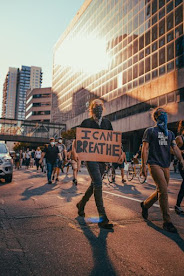“The debt pandemic”: Time to update our thinking.
 |
| Instability: Among the results of fragile economies |
This has given rise to fears of global debt distress and
defaults. Measures enforced to contain the public health crisis caused by
COVID19 led to an economic crisis that gave birth to a “debt Pandemic.”
However, there
appears to be new thinking about public debt that dispenses with frugality. In
fact, some economists disparage frugality as a “Zombie idea” -a bad idea that
lacks evidential support but still keeps influencing policy decisions.
The former IMF Chief Economist, Olivier Blanchard, set the ball rolling last year when he argued in a speech that, “governments can borrow far more than previously believed.” Other Economists, Nobel Prize laureates to boot, agree.
Countries borrow to bridge financing shortfalls due to
inadequate taxes. They do this to keep economies on track because the private
sector is not a good stabilizer of the economy. In fact, trouble in the private
sector has at times forced governments to incur huge debts. For example, the
2008, financial meltdown, forced governments in the developed West to step in
to save behemoths in the financial and manufacturing sector, says Australian
Economist John Quiggin. This bailout, says the Economist Channel, raised the public
debt in the developed West, to 105 percent of GDP in the decade to 2018.
The main driver of growth in sovereign debt is wars. Governments borrow way beyond their GDP to finance wars. The COVID-19 pandemic is something worse than war. Containment measures have triggered an economic crisis of global proportions. This has increased demand for government financial support for the private sector and retrenched workers in addition to public health services. Now the government is “the investor and insurer of the last resort,” argues Professor Robert Reich in an interview with CNBC. Sergio Rebello of North Western University shares a similar view in an article in the Finance and Development Magazine, published by the IMF.
The IMF itself appears to have dispensed with frugal management of the budgets, choosing to give support to countries in need without looking at their debt ratios- in some instances, interest-free, to poor countries. So far, the IMF has disbursed $250 billion of its US$1 trillion war chest to help its members cope with the effects of COVID-19 in this way.
Close home, public debt in Kenya as at the end of June 2020 stood at $62.8 billion or 67.5 percent of the GDP estimated at $93 billion. There are plans to borrow another US$100 million to bridge the financing gap created by tax shortfalls amid high demand for public funding.
Large sovereign debts
are always (at least in the past) cause for concern as anti-debt warriors fear
to bequeath the next generation with debts. However, frugality could also bequeath under
development, social and economic inequality, poverty, and social instability.
The COVID-19 pandemic has derailed everyone, including governments. Its full impact is not yet fully understood. That leaves all groping in the dark. Its ramifications this far suggest that we must update our thinking on public debt because it seems inevitable. There is a growing consensus among Economists that sovereign debt is not such a bad thing after all. Top Economists dismiss the neo-liberal view that government should “cut their cloth according to their size” blaming it for the economic fragilities we are experiencing.
COVID-19 exposed the
fragility of the global economic and financial system. Part of the causes of
the fragility is false hypotheses that influenced economic policymaking in the
last fifty years or so. Among these is the small government hypothesis. These
untruths stripped economies of resilience, replacing it with efficiency which
in turn produced fragility. Post-CoVID-19, these inequalities, and other social
injustices will only get worse if governments do not do something. We now hear
of the mantra “build back better.” This is the recognition that the current
economic system is not sustainable and could pose a greater risk to stability
in the future.
That means a paradigm shift: Economies will have to reduce
or eliminate income- inequalities and social injustices, and protect the
environment. This means bigger, assertive governments that will lead in green
investments and counter-balance the private sector influence. Given the massive
capital outlay needed, governments will be the lead investor. If taxes cannot
finance all these needs-and they cannot- then governments must borrow to invest
in enablers.
Some private-sector firms will not survive the pandemic, and
that means growing unemployment and deepening poverty. This will force
governments to bail them out. A case in point is the grounding of Airlines in
the US because business is down 70 percent.
Since June, the airline industry in the US has survived on a $25 billion
federal government support. Now that the
funds have run out, the airlines are retrenching more than 40 thousand
employees unless congress pumps another $25 billion to see them through
December 31.
So governments, in the midst of a health pandemic and its attendant economic crisis, have to not
only bailout weak sectors, but also must
invest in infrastructure – building
roads, schools, power stations, hospitals, and strengthen the public health
infrastructure - to create jobs and also bring back resilience to the economic
and financial system. Resilience to future shocks is hinged on stronger and
larger governments.



Comments
Post a Comment